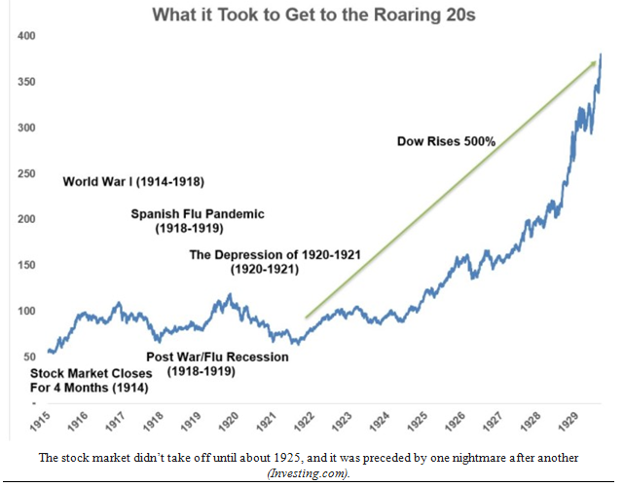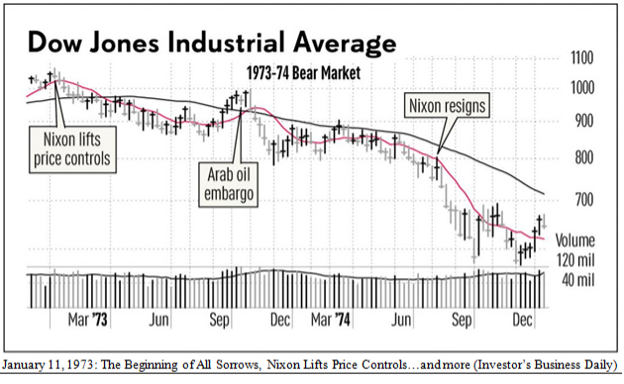For weekend reading, Gary Alexander, senior writer at Navellier & Associates, offers the following commentary:
The personality of each decade often comes clear in the year ending in 3: For instance, grandfatherly Ike took office in January 1953, with Lucy and Uncle Miltie defining our TV life after the end of wars abroad in Korea and civil war at home with McCarthy.
The 1960s began starkly after the shocking assassination of President John Kennedy on November 22, 1963, and the Beatles musical invasion the next week. The inflationary 1970s began with the Yom Kippur War in October 1973 and Arab Oil embargo that followed.
Q4 2022 hedge fund letters, conferences and more
I could expand such scenarios, but let me demonstrate by focusing on this week in 1923 and 1973 and ask – Are we on the verge of another Roaring Twenties, or another Staglationary Seventies? (Or neither?)
A New Dawn in America: Thursday, January 4, 1923
Everybody knows the story of the Jazz Age and the stock market mania of the 20s. Jazz, prohibition, and radio were born together, with the first great recordings by Louis Armstrong, Jelly Roll Morton, the New Orleans Rhythm Kings, and many other jazz pioneers in 1923, abetted by records but supercharged by radio.
On Thursday, January 4, 1923, the first radio network in the U.S. was created when the original AT&T company used special lines to broadcast the same programs simultaneously on New York City’s WEAF and Boston’s WNAC. That included jazz music, sporting events, politics, and vital news events.
But on the same day, two spiritual prophets and an Irish “investor” signaled that Americans were ready for a sea change of growth after World War, global pandemic, hyper-inflation, and market crash.
On that day, a starry-eyed French immigrant, Emile Coue, arrived in New York harbor, with his popular new secular Gospel, “Every day, in every way, I’m getting better and better.” It was a form of self-hypnotism that took America by storm.
The “Miracle Man of France” began a three-week lecture tour of America, with one of his final stops speaking before thousands in Chicago, where he apparently made a paralyzed man rise and walk. Coue found Americans more accepting (gullible?) to his message than Europeans.
“The French mind,” he wrote in 1923, “prefers first to discuss and argue on the fundamentals of a principle before inquiring into its practical adaptability to everyday life. The American mind, on the contrary, immediately sees the possibilities of it, and seeks… to carry the idea further…”
On that same day, evangelist Aimee Semple McPherson held her first service in the 5,300-seat Angelus Temple, or the Church of the Four-Square Gospel in the Echo Park neighborhood of Los Angeles. By 1925, she had 30,000 members and eventually a radio audience of millions, rivalling the popularity of Babe Ruth or Jack Dempsey.
She was conservative but radical as she opened her revivals and services to black and brown races. The Ku Klux Klan once came to protest, but her message of love was apparently so convincing that the only evidence of the klan’s protest was their discarded white robes and hoods.
Which brings us to the Irish “investor,” Boston’s Joseph F. Kennedy, Sr., who opened his New York brokerage office in the Waldorf Astoria, using several telephone and telegraph lines to contact the stock room floor.
Within a decade, he made a $2 million fortune trading stocks (through insider trading, price manipulation, then “shorting” stocks in 1929), before becoming the first head of the SEC. He made another fortune in bootleg hooch, although this evidence is sketchier, as its bottom line is off the books.
Throughout this all, Calvin Coolidge’s Secretary of the Treasury, Andrew Mellon, cut taxes and business regulations and basically allowed business leaders the run of the nation, as the Jazz Age grew jazzier.
Speaking of which, the #1 most popular song of the week of January 6-12, 1923, was George Gershwin’s hit for the George White Scandals of 1922, with words by his brother Ira (using a pen name), and Buddy De Sylva: “I’ll Build a Stairway to Paradise,” which fit the message of Aimee and Emile like a glove:
I’ll Build a Stairway to Paradise (#1 Song, January 6-12, 1923)
Verse (in part)
It’s madness, to be always sitting around in sadness,
When you could be learning the steps of gladness.
Begin today! You’ll find it nice,
(It’s) the quickest way to paradise.
Chorus (in part)
I’ll build a stairway to Paradise
With a new step ev’ry day!
I’m gonna get there at any price;
Stand aside, I’m on my way!
Thursday, January 11, 1973 – The Day the Market Peaked (for a Decade)
January 11 marked the absolute peak of the stock market in the 1970s, a mark it would not exceed for nearly a decade in nominal terms, and not for over a decade in “real” (inflation-adjusted terms).
On January 11, 1973, the Dow reached a then-record high of 1051.70. Following that peak, the Dow fell by nearly half (-45%) by the end of 1974, the worst bear market for the second half of the 20th Century.
Looking at that specific date in context, what caused the market to peak on this day and then go down?
(1) President Richard Nixon ended the wage and price control program he began in August of 1971. In less than 18 months of this misguided program, the national debt, inflation, and unemployment were all rising steadily, despite controls, and soon were rising even faster, after the artificial controls were lifted.
(2) Also on this date in 1973, the trial of the Watergate burglars began in Washington DC with the first convictions coming by month’s end.
(3) As hard-core, baseball fans know, January 11, 1973, is also the beginning of the decline of Western Civilization: That’s the day the American League adopted the “designated hitter” rule, where pitchers did not have to take a turn at bat – the end of well-rounded athleticism in The Great American Pastime.
Seriously, January 1973 marked the end of the fruits of one era of bad leadership (the Vietnam War under LBJ) and the beginning of another (Watergate under Nixon), with several other crises, plus inept economic leadership from two clueless Fed chairmen, Arthur Burns and G. William Miller.
I’m open for suggestions, but it seems like 2023 is a near match for 1973, and a polar opposite of 1923, but nothing is set in stone. We can learn from history by reading more about the 1920s and avoid the mistakes of the 1930s or 1970s. These swings are avoidable by reading and heeding the lessons of history.
And, by the way, the #1 hit songs in January 1973 were far from Building a Stairway to Paradise:
- For the weeks of January 6 and 13: the #1 song was “You’re So Vain,” by Carly Simon
- For the weeks of January 20 and 27: #1 was “Superstition” by Stevie Wonder















